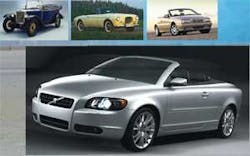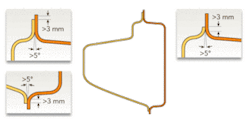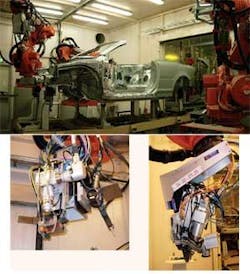Volvo C70 laser challenge
Niclas Palmquist and Tore Salmi
Laser welding and brazing improve auto-component manufacture
When Volvo Cars set out to develop its new C70 convertible, the performance requirements of the vehicle, in terms of weight, stiffness, and structural strength, were substantially increased compared to the existing model (see Fig. 1). To meet this challenge, many new ingredients were entered into the project, one of which was the use of laser welding and brazing.
The C70 was developed around the already existing C1/P1 platform, in common use in the Ford Focus and Mazda 3, instead of the 850 platform that was used for the old model. One of the challenges was to utilize a three-piece foldable hard roof, because the new C70 was supposed to replace the old coupe and convertible. Product development, design, and production were handled via a joint venture between Volvo Cars and Italian-based Pininfarina. The location of production chosen for the new C70, a plant in Uddevalla (Sweden), also produced the old C70 model. Several applications of laser welding and brazing were introduced, enabling many product improvements.
Improved body features
The combination of 85% high-strength steel, 10.7 meters of laser welding, and 0.2 meters of laser brazing, together with design improvements, made a remarkable impact on torsional stiffness. It was increased 250% compared to the old C70, and the lightweight body construction index was lowered by a factor of 2.7 (see Fig. 2).
Four different laser welding applications and one laser brazing application (the first in-line application) were selected, all with a different approach and use of laser technology (see table). Laser welding of the lower and upper flange of the sill made a basic design improvement possible for the sill structure. Both the upper and lower flanges could be dramatically reduced when laser welded, increasing the sill-beam cross section. This laid the basis for a dramatic improvement in the torsional stiffness of the body (see Fig. 3).
null
Laser welding, with its single-side access capability, was also used for connecting the rear fender to the sill outer, and laser brazing was used to connect the A-pillar cover to the windscreen cross member. This took advantage of the laser’s single-side access feature (see Fig. 4).
Laser station from Permanova
The original production volume was set low at 17,000 cars per year, an increase in capacity from the 7800 units of the previous model. Thus, the long cycle time, slightly more than four minutes, made possible the multilaser-process approach needed for the car-body joining tasks.
Permanova Lasersystem was chosen as the turnkey supplier for the laser station. The laser station is equipped with a 4-kW TRUMPF lamp-pumped Nd:YAG laser with four fiber outputs and five fibers—four in use and one spare for quick exchange. The fibers are connected to four different tools mounted on three ABB robots.
One robot on each side welds the upper and lower sill joints (inner to outer sill). These two robots each carry a Permanova welding tool with double pressure wheels capable of clamping forces up to 1600 N and seam-tracking features to do an overlap edge weld by following the upper material in the joint and positioning the laser beam at the edge of that material (see Fig. 5). The same tools also weld the overlap edge weld for the rear fender to sill by folding away the lower wheel and making a “normal” single-wheel overlap edge weld. To manage these two types of welds that have a large thickness difference, the head was equipped with a motorized focusing unit, allowing in-between weld adjustments of the focus position of the laser beam from -10 to +20 mm.
Of the 249s cycle time (250 s allowed), the laser has an impressive 82% “beam-on-time,” or 204 s. This is only possible by optimizing the process such that the laser light is switched from one tool to the other when a seam is finished and another robot with its tool is ready and in its start position. In this way, any time spent for robot movements within the work cycle can be minimized.
System-integrator challenges
Permanova project leader Lars-Erik Jansson says, “From the car manufacturer’s point of view, the challenge should be in the design of the car itself, not in inventing and applying new, potentially risky technologies, to enable the development and production of the new car features and capabilities.” In the Volvo C70 project, Volvo Cars and Pininfarina faced a number of firsts:
- a three-piece foldable hard roof (old coupe and convertible to be replaced)
- abandoning the old Volvo 850 platform in favor of the C1/P1 Ford/Mazda platform
- introducing laser brazing as an in-line process in a car manufacturing line
- introducing a laser welding application in-line in thicker material, where the strength and integrity of the weld is key for total stiffness and strength of the car
- again using two laser processes in-line for four different applications in the car body (last time was combining laser welding and cutting in one station for the old C70).
Jansson continues, “The laser processes (welding and brazing) were, of course, important elements in the Volvo story. To implement these processes and to minimize the total project risk for the laser station, Pininfarina/Volvo played it safe by again selecting Permanova for this turnkey supply. In this way, Volvo gained several important advantages:
- technically and commercially proven experienced laser project management
- innovative laser process tool-development capacity
- professional system-integrator knowledge and experience needed to handle all system, laser process, and line communication tasks
- local qualified service and maintenance, with a short response time.”
Flexibility in system and tool design, as well as in project management, proved to be key demands on the integrator. Last-minute additions and car-design changes, for example, required adding a third robot into the laser station with a new tool.
Also, start and ramp-up of production of the new C70 model while still producing the old model was a challenge, requiring weekend work outside normal production hours for tests back and forth. New special robot and laser tool solutions were developed. In addition, other old station modifications (new station housing, new laser with higher power, and more flexible tooling) demanded firm project control and an experienced birds-eye view of the situation.
From the Permanova point of view, this particular project meant commercialization of two new laser tools—the Programmable Focusing Unit MFU (see Fig. 7), which made it possible to easily reprogram the focus position to adapt for different material thicknesses in different joints, despite a fixed pressure wheel determined nominal position, and the foldable bi-directional pressure fingers (see Fig. 8). This tool solution enabled production of both car sides with only one tool. Also the spare-tool inventory was reduced.
Niclas Palmquist is in manufacturing engineering at Volvo Cars and Tore Salmi ([email protected]) is with Permanova Lasersystem.









